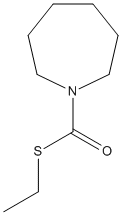Molinate
Herbicide. Protection from DBDCVP neuropathy by molinate is correlated with inhibition of neuropathy target esterase NTE
General
Type : Carbamate,Herbicide,Sulfur Compound,Azepane,Not A\/B H target
Chemical_Nomenclature : S-ethyl azepane-1-carbothioate
Canonical SMILES : CCSC(=O)N1CCCCCC1
InChI : InChI=1S\/C9H17NOS\/c1-2-12-9(11)10-7-5-3-4-6-8-10\/h2-8H2,1H3
InChIKey : DEDOPGXGGQYYMW-UHFFFAOYSA-N
Other name(s) : Ordram,2212-67-1,Jalan,S-Ethyl azepane-1-carbothioate,Higalnate
MW : 187.30
Formula : C9H17NOS
CAS_number : 2212-67-1
PubChem : 16653
UniChem : DEDOPGXGGQYYMW-UHFFFAOYSA-N
IUPHAR :
Wikipedia :

Target
Families :
Stucture :
Protein :
References (5)
| Title : Evolutionary expansion of the amidohydrolase superfamily in bacteria in response to the synthetic compounds molinate and diuron - Sugrue_2015_Appl.Environ.Microbiol_81_2612 |
| Author(s) : Sugrue E , Fraser NJ , Hopkins DH , Carr PD , Khurana JL , Oakeshott JG , Scott C , Jackson CJ |
| Ref : Applied Environmental Microbiology , 81 :2612 , 2015 |
| Abstract : Sugrue_2015_Appl.Environ.Microbiol_81_2612 |
| ESTHER : Sugrue_2015_Appl.Environ.Microbiol_81_2612 |
| PubMedSearch : Sugrue_2015_Appl.Environ.Microbiol_81_2612 |
| PubMedID: 25636851 |
| Title : Acetylcholinesterase inhibitors: pharmacology and toxicology - Colovic_2013_Curr.Neuropharmacol_11_315 |
| Author(s) : Colovic MB , Krstic DZ , Lazarevic-Pasti TD , Bondzic AM , Vasic VM |
| Ref : Curr Neuropharmacol , 11 :315 , 2013 |
| Abstract : Colovic_2013_Curr.Neuropharmacol_11_315 |
| ESTHER : Colovic_2013_Curr.Neuropharmacol_11_315 |
| PubMedSearch : Colovic_2013_Curr.Neuropharmacol_11_315 |
| PubMedID: 24179466 |
| Title : Toxicity of atrazine and molinate to the cladoceran Daphnia carinata and the effect of river water and bottom sediment on their bioavailability - Phyu_2004_Arch.Environ.Contam.Toxicol_46_308 |
| Author(s) : Phyu YL , Warne MS , Lim RP |
| Ref : Archives of Environmental Contamination & Toxicology , 46 :308 , 2004 |
| Abstract : Phyu_2004_Arch.Environ.Contam.Toxicol_46_308 |
| ESTHER : Phyu_2004_Arch.Environ.Contam.Toxicol_46_308 |
| PubMedSearch : Phyu_2004_Arch.Environ.Contam.Toxicol_46_308 |
| PubMedID: 15195802 |
| Title : Effects of S-ethyl hexahydro-1H-azepine-1-carbothioate (molinate) on di-n-butyl dichlorovinyl phosphate (DBDCVP) neuropathy - Moretto_2001_Toxicol.Sci_62_274 |
| Author(s) : Moretto A , Gardiman G , Panfilo S , Colle MA , Lock EA , Lotti M |
| Ref : Toxicol Sci , 62 :274 , 2001 |
| Abstract : Moretto_2001_Toxicol.Sci_62_274 |
| ESTHER : Moretto_2001_Toxicol.Sci_62_274 |
| PubMedSearch : Moretto_2001_Toxicol.Sci_62_274 |
| PubMedID: 11452140 |
| Title : Cholinesterase activity and hematological parameters as biomarkers of sublethal molinate exposure in Anguilla anguilla - Sancho_2000_Ecotoxicol.Environ.Saf_46_81 |
| Author(s) : Sancho E , Ceron JJ , Ferrando MD |
| Ref : Ecotoxicology & Environmental Safety , 46 :81 , 2000 |
| Abstract : Sancho_2000_Ecotoxicol.Environ.Saf_46_81 |
| ESTHER : Sancho_2000_Ecotoxicol.Environ.Saf_46_81 |
| PubMedSearch : Sancho_2000_Ecotoxicol.Environ.Saf_46_81 |
| PubMedID: 10805997 |